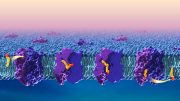
Scientists have discovered an enzyme named PUCH, crucial in halting the spread of parasitic DNA sequences in our genome. This discovery could provide insights into how our body identifies and combats both internal threats (like genomic parasites) and external ones (such as viruses and bacteria).
Professor René Ketting’s team at the Institute of Molecular Biology (IMB) in Mainz, Germany, along with Dr. Sebastian Falk’s group at the Max Perutz Labs in Vienna, Austria, have discovered a new enzyme, PUCH, which plays a key role in preventing the spread of parasitic DNA in our genomes. This breakthrough could offer deeper understanding of how our systems recognize and combat pathogens, helping fend off infections.
Our cells are under constant attack from millions of foreign intruders, such as viruses and bacteria. To keep us from getting sick, our bodies have an immune system – a whole army of cells that specializes in detecting and destroying these invaders. However, our cells face threats not only from external enemies but also from within.
Genomic parasites populate a large part of the genome
An amazing 45 percent of our genome is comprised of thousands of genomic parasites, i.e., repetitive DNA sequences called transposable elements (TEs). TEs are found in all organisms but have no specific function. They can, however, be dangerous. TEs are also called “jumping genes” because they can copy and paste themselves into new locations in our DNA.
This is a major problem because it can lead to mutations that cause our cells to stop working normally or to become cancerous. As such, almost half of our genome is engaged in a constant guerrilla war with the other half as TEs seek to multiply, while our cells try to prevent them from spreading.
How do our cells combat these internal enemies? Fortunately, our cells have evolved a genomic defense system of specialized proteins whose job it is to hunt down TEs and prevent them from replicating. In a new paper published in Nature, René Ketting and Sebastian Falk together with their research teams report their discovery of PUCH – a completely new, previously unknown type of enzyme, which is key to this genomic defense system. They found that PUCH plays a crucial role in producing small molecules called piRNAs, which detect TEs when they attempt to “jump.” They then activate the genomic defense system to stop TEs before they paste themselves into new locations in our DNA.
The researchers discovered PUCH in the cells of the roundworm C. elegans, a simple invertebrate often used in biological research. However, the findings may also shed light on how our own immune system works. PUCH is characterized by unique molecular structures called Schlafen folds.
Enzymes with Schlafen folds are also found in mice and humans, where they appear to play a role in innate immunity, the body’s first line of defense against viruses and bacteria. For example, some Schlafen proteins interfere with the replication of viruses in humans. On the other hand, some viruses such as monkeypox viruses, for example, may also use Schlafen proteins to attack the cell’s defense system. René Ketting suspects that Schlafen proteins may have a wider, conserved role in immunity in many species, including humans.
“Schlafen proteins may represent a previously unknown molecular link between immune responses in mammals and deeply conserved RNA-based mechanisms that control TEs,” said Ketting, who is also a Professor of Biology at Johannes Gutenberg University Mainz (JGU). If so, Schlafen proteins may represent a common defense mechanism against both external enemies like viruses and bacteria as well as internal ones such as TEs.
“It’s conceivable that Schlafen proteins have been repurposed into enzymes that protect cells from infectious DNA sequences, such as TEs,” added Sebastian Falk. “This discovery may profoundly impact our understanding of innate immune biology.”
Reference: “piRNA processing by a trimeric Schlafen-domain nuclease” by Nadezda Podvalnaya, Alfred W. Bronkhorst, Raffael Lichtenberger, Svenja Hellmann, Emily Nischwitz, Torben Falk, Emil Karaulanov, Falk Butter, Sebastian Falk and René F. Ketting, 27 September 2023, Nature.
DOI: 10.1038/s41586-023-06588-2









I’d like to know more about parasitical infections and how they could relate to living in an enclosed atmosphere/space alongside 50 or more other individuals some have on a scale of 1 to ten ten being bad I’d say 35% of residents have severe to septic infections in their extremities recent information I’ve found says these buildings were labeled beaver fever before being fixed on the quick and rented out to us
Listen, i have discovered it is likely all humans have the same parasite infection probably man made. You can tell by adjusting the light and contrast on most photos. What you see is horrifying. I’ve photoed people in Africa,SE Asia, North and South America. I believe this infection probably came out 3 to 5 years ago.
I’m Muhammad Sohail abbasi from Azad Jammu and Kashmir (Pakistan).
I’m an undergraduate student at department of biotechnology in Mohi ud din islamic university nerian sharif AJ&K. I’m a researcher also. My area of interest is genetics especially cancer biology, CRISPR Gene editing, targeted drug delivery systems and innovative medicines. A very hot and recent discovery ”CYDENT”a base editing system a really like it. A wonderfull discovery. Toaday I’m scrolling for such a topic as genetic mutations is very attractive to me. I found this article. It’s a very novel and awesome discovery ”PUCH and PiRNAs”. It will be prove very effective and valuable tool for treating Transposable elements and genetics parasite. Please must share such inovative and modern research on global plates and search engines like Google.thank you so much.
I was beginning to think that no one actually did any real work in science, because so much of it is trashy and of low quality;I really enjoyed reading this article, because it raised some interesting questions concerning the large genetic makeup of some species having apparent worthless copies of itself other than the ability to mutate under environmental stress into a modified species; the wonderful cockroach comes immediately to mind.